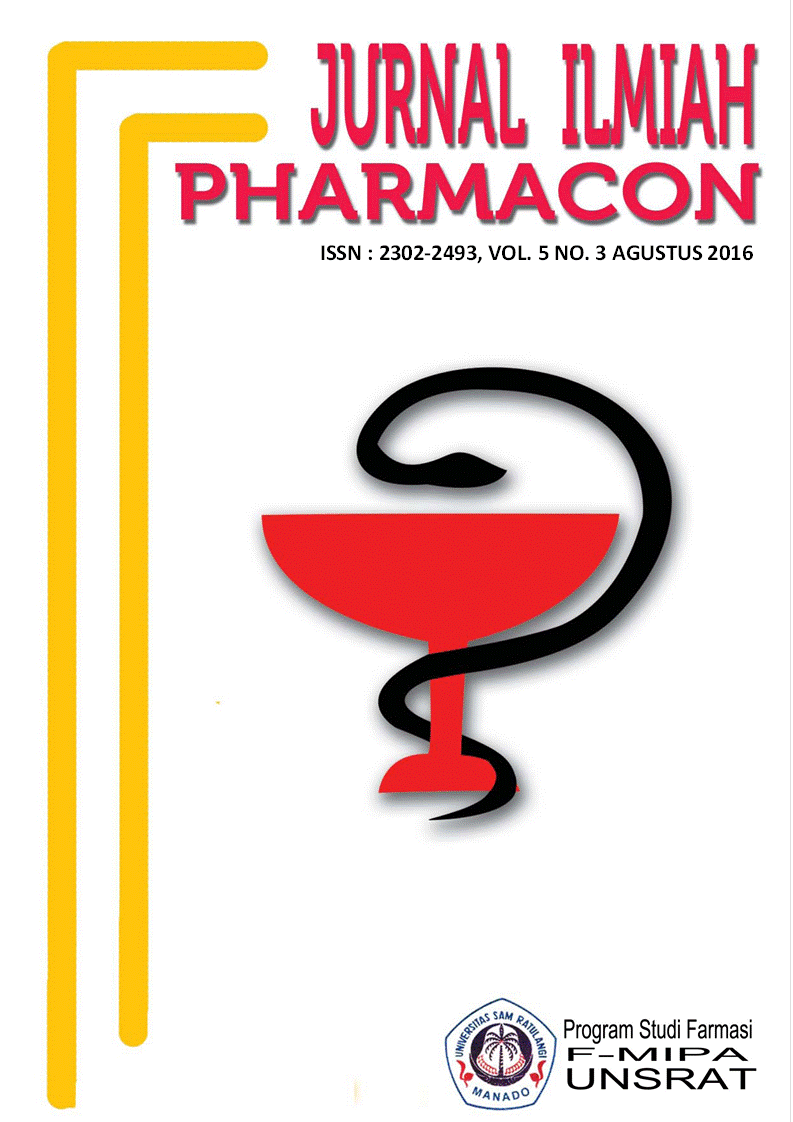FORMULASI SEDIAAN GEL MINYAK ATSIRI DAUN SEREH (Cymbopogon citratus) SEBAGAI ANTISEPTIK TANGAN
DOI:
https://doi.org/10.35799/pha.5.2016.12941Abstract
FORMULASI SEDIAAN GEL MINYAK ATSIRI DAUN SEREH (Cymbopogon citratus) SEBAGAI ANTISEPTIK TANGAN
Noriko Manus1), Paulina V. Y. YamLean1), Novel S. Kojong1)
1)Program Studi Farmasi FMIPA UNSRAT Manado, 95115
ABSTRACT
Lemongrass (Cymbopogon citratus) is a plant known to produce essential oil. The essential oil produced from the leaves of the Lemongrass has many benefits and one of them is as antiseptic properties. The objective of this study is to compose a formula and then examine the effectiveness of hand antiseptic properties in gel produced from the leaves of Lemongrass essential oils (Cymbopogon citratus) in three different concentration formula, which are: 5%, 10% and 15% with CMC-Na as the gel base. Tests performed on three gel formulations include physical properties among others organoleptic test, pH, homogeneity, spreading test, consistency and effectiveness of antiseptic. Antiseptic effectiveness testing was conducted using a modified replica using handsanitizer Carex® (positive control), base gel (negative control) and gel formulation of 5%, 10% and 15%. The resulting data of antiseptic test was analyzed using One Way Anova method with 95% of trustworthy level. The resulting gel shows that the essential oil of the Lemongrass leaves is able to be formulated to a gel form which meets the test parameter, among others organoleptic test (semisolid, clear and typical scent of Lemongrass), scale of pH 6 is still in the interval scale which is safe for skin, homogeneity with no visible coarse upon such gel formula, spreading test level around 5,1-5,5 shows semisolid consistency which is very convenient to use and consistency test in which the separation phase did not occur. Gel which contains 15% of essential oil of the Lemongrass leaves showed the decrease of best average number of colony which is 8.
Keywords: Lemongrass leaves, essential oil, antiseptic gel, replica method
Â
Â
ABSTRAK
Â
Sereh (Cymbopogon citratus) merupakan tanaman penghasil minyak atsiri. Minyak atsiri yang terkandung dalam Sereh memiliki khasiat salah satunya sebagai antiseptik. Penelitian ini bertujuan untuk membuat formulasi serta menguji efektivitas antiseptik tangan dari sediaan gel minyak atsiri daun Sereh (Cymbopogon citratus) dengan tiga variasi konsentrasi, yakni 5%, 10% dan 15% dengan CMC-Na sebagai basis gel. Pengujian yang dilakukan terhadap ketiga formulasi meliputi sifat fisik gel yaitu, pengujian organoleptik, pH, homogenitas, daya sebar, konsistensi serta efektivitas antiseptik. Pengujian efektivitas antiseptik dilakukan dengan metode replika yang dimodifikasi menggunakan handsanitizer Carex® (kontrol positif), basis gel (kontrol negatif) dan sediaan gel 5%, 10%, 15%. Data pengujian antiseptik yang diperoleh dianalisis dengan One Way Anova dengan taraf kepercayaan 95%. Hasil pengujian menunjukkan bahwa gel yang dihasilkan memenuhi parameter uji, diantaranya uji organoleptik (semipadat, jernih dan bau khas Sereh), pH 6 yang masih dalam interval aman pH kulit, homogenitas dengan tidak terlihat adanya butiran kasar terhadap semua formulasi gel, uji daya sebar yang berkisar 5,1-5,5 menunjukkan konsistensi semisolid yang sangat nyaman dalam penggunaan dan uji konsistensi dengan tidak terjadi pemisahan fase. Gel minyak atsiri daun Sereh memiliki efektivitas antiseptik pada konsentrasi 15% yang memperlihatkan adanya penurunan rata-rata jumLah koloni yang paling baik yakni 8.
Â
Kata kunci : daun Sereh, minyak atsiri, gel antiseptik, uji replika
Â
Downloads
Published
How to Cite
Issue
Section
License
Authors who publish with this journal agree to the following terms:
- Authors retain copyright and grant the journal right of first publication with the work simultaneously licensed under a Creative Commons Attribution-NonCommercial 4.0 International License that allows others to share the work with an acknowledgement of the work's authorship and initial publication in this journal.
- Authors are permitted and encouraged to post their work online (e.g., in institutional repositories or on their website) prior to and during the submission process, as it can lead to productive exchanges, as well as earlier and greater citation of published work (See The Effect of Open Access)










